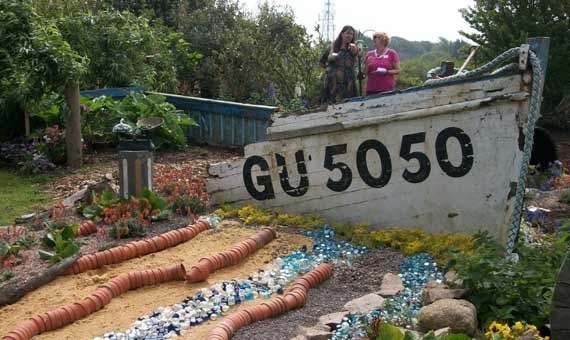
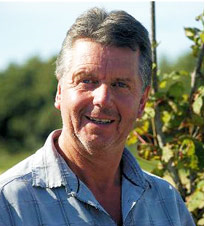
About Nigel Clarke
Nigel works on both Foods Matter and Green Legacy Guernsey websites. The foods matter website is an absolute must if you suffer from allergies and is run by the wonderful Michelle Berriedale-Johnson, who has also provided an article for Green Fingers. The article on Green Legacy Guernsey will help you get a picture of how after about fifty years working with plants Nigel found himself writing pointers on how to create an Allergy friendly garden. Another site recommended by Nigel is Safe Gardening. This website is the brainchild of Thomas Leo Ogren, whose latest book will provide you with everything you need to know on creating an allergy friendly garden which is now available on Amazon.
Identifying the problem
You probably think that as we have always had pollen there is nothing you can do but take the medicine and stay inside when the pollen count is high. It’s important you know that if you, your family and/or friends suffer badly from pollen allergies, the right advice can make self-help possible. Amazon CEO Jeff Bezos says we're all wrong a lot of the time, and backtracking on an opinion shows that you're open to new ideas that challenge the way you view the world.
Please read this e-mail I received from Professor Nicolaos Papadopoulos, Professor of Allergy & Paediatric Allergy, Royal Manchester Children's Hospital
“Dear Nigel
I only recently came across the work you and Tom Ogren are doing and I am intrigued. I have to admit that medical texts do not include plant manipulations as a management tool for allergies. There are many anecdotal views on how changes of plant populations may affect allergies in a particular location, but not any formal reporting. However, this makes perfect sense and needs to be evaluated”
So that settles that, you do not have to be a victim. You have it from one of the top Allergy Professors in Europe if not the world. We manipulate the urban environment, all we have to do is show less apathy and manipulate with more empathy for allergy sufferers. If we don’t have allergies ourselves, we need to understand that life is hell for those that do. It’s the wrong plant choices and the lack of diversity in urban landscapes which are mostly responsible for having a detrimental effect to the health of millions of men, women and children.
Solving the problem
To solve any problem you must have identified it. I’m hoping you agree that we have done that. The good news is that we can now concentrate on the solution. You now need to identify the individual plants you spend most time around. Tom Ogren is explicit when he says that most pollen allergies are caused by close proximity and over exposure. Remove or reduce the cause of a problem and you reduce or eliminate the effect. Sit too close to a fire and you get burnt. Move away from the fire or remove it and you don’t get burnt. Pollen is not a fire, although it might feel like one in your eyes, nose and mouth when you are in close contact and it triggers your allergy.
Allergy Ratings
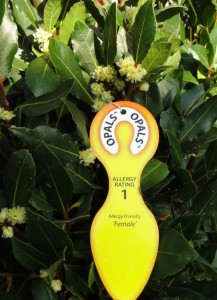
The Allergy Fighting Garden’s OPALS ratings will help you identify the likely triggers. Good, now we need a bit of empathy, this time it’s for the plants. We are where we are, the goal is not to butcher everything in sight, it’s to make sure your allergy gets no worse, hold it where it is, introduce the right plants and over time reduce it. In other words you need to have a plan.
Start by working on the plants that are bothering you most and make sure that new introductions have low OPALS rating.
Watering
I’m assuming you had a burning desire to make positive changes to your environment which would benefit yourself, and your family including friends. You have evaluated what needed to be done and with the help of Tom Ogren’s book you have done it.
You now need to make sure you maintain your plants and keep them healthy. Sick plants will attract fungal diseases like mildew and bugs with the mould attracting dander. If I’m asked the two most likely reasons that plants get sick they are, too much water and too little water. The simple cure is the following. Insure when you water that it will be removed by the plants taking it up and any excess water that is left can drain down. Contrary to popular belief, compost in containers will hold up to its capacity of water and then release it providing it has somewhere to go. If it hasn’t, the end result will be waterlogging and plant death. If you hand water, over the top is fine but only early morning as during the day can cause scorch if it’s sunny and watering in the evening can invite fungal diseases in if the foliage stays wet all night.
The easiest way to be safe is a drip irrigation system that is targeted to specific plants and has an automatic battery operated controller turning it on and off. Have an extra drip in a two litre jug. You can check that the controller has watered each day and you will know exactly how much so you can increase or reduce depending on conditions.
Diversity
Choose a mix of plants for balance and remember that the lower the ratings the lower the risk of triggering your pollen allergy. One undeniable truth, male plants have pollen, females don’t. Two female plants we have trialled as hedging or standalone shrubs are Coprosma “Big Glossy Girl” and Coprosma “Exotica Glossy Girl” which has beautiful variegated foliage. We also have three female Acers all with beautiful autumn foliage. These are all available now. We will have a new Bay in the autumn, Laurus nobilus “Guernsey Girl”. Other trees that are suitable for allergy friendly gardens and attract wildlife are Amelanchier, Sorbus, Hawthorne and most fruit trees.
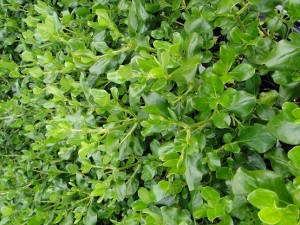
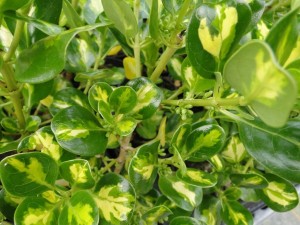
Seasons
For the last twenty six years we have worked on two seasons, not four. First season is the summer and the second season is the other three all in one. Assuming you now have your allergy friendly garden established, I recommend seventy to eight per cent permanent ALLERGY FRIENDLY plants then all you have to do is have a good tidy up, and get in some summer colour over the next few weeks. The main tidy up is September/October, clear away the summer plants and introduce plants that will give you colour for the following eight months. Again, check OPALS
Finally...
Why do I do what I do? Hopefully you will have read the Foodsmatter article. When customers come into my Plant Centre I don’t have their health records. Up to about eight years ago I didn’t realize that a high percentage of the population, over 20% and rising could not enjoy the natural environment as I do. OPALS tags on my plants means that I don’t need your health records. Armed with the book The Allergy-Fighting Garden you can now take responsibility for yourself and those you care about. Plant allergy ratings allow you to make educated decisions on plants chosen. To be honest, now that I have started, I can’t imagine selling my plants any other way.
